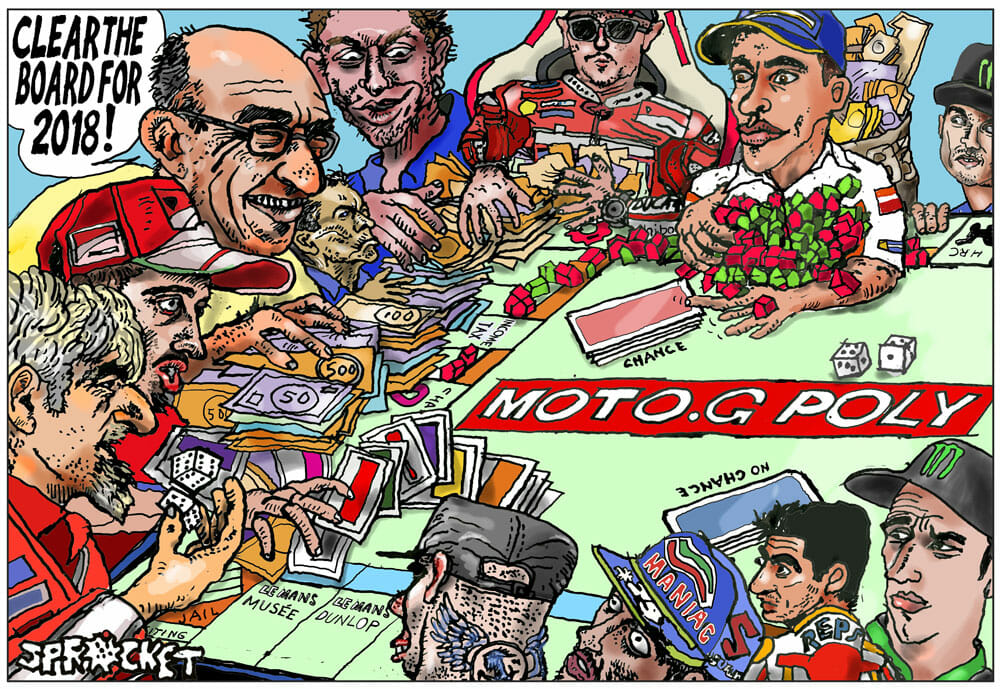Michael Scott | January 30, 2018
COLUMN
More Questions Than Answers
The MotoGP World Championship turns 70 this year. The series is pretty spry for a septuagenarian. MotoGP’s exuberance is a measure of its success: the growing pains of the last decade and the ghastly proddie-based CRT bikes now all but forgotten. It is once again paradoxically youthful and renewed.
It is traditional at this pre-season point to look ahead with optimism. This is, of course, something those of us who love racing can hardly avoid. But it’s not too much of a stretch: for 2018, there seems little need to break out the happy pills or contort the imagination in the hope and expectation of another fine and compelling battle. Let the new Golden Age continue.
Unless Honda and Marquez spoil the party.
Of course, recent statistics do suggest racing might have become predictable. Marc Marquez has been dominant, winning four times in the past five years, including the last two years straight. But only one of those titles was straightforward. Honda’s endless and obsessive quest for improvement has led them into some dark places, and he’s really had to work for it every year except 2014. Last year the issue remained open until the last of 18 races.

Can that happen in 2018? Depends if Honda engineers, once again, confuse themselves with yet more major mechanical changes. Something of a habit for the world’s leading manufacturer. They’re never satisfied with what they’ve got. And who can say they’re not right to do so? But they do make life harder for themselves and their riders.
Over the past three years, step by step, Honda radically altered several crucial aspects. First came the ultra-light crankshaft, which spoiled acceleration by making throttle response very spiky. Then they reversed crankshaft rotation, coming into line with the opposition by spinning it backwards, but giving riders and chassis engineers a whole new set of responses and equations with which to come to terms. Then last year came new bigger-bang firing intervals: another significant change. And all this while also struggling to adapt from in-house electronics to the unified software and hardware. With engine design frozen from the first race, no quick fixes were available. Engineers and riders were given a big hill to climb. In 2015 it proved too steep; Yamaha’s Lorenzo and Rossi were first and second overall. The next two years made Marquez work very hard to get back on top.
We shall see if HRC can stop itself from doing it again.
In this particular regard, the dumb-down engine-freeze rules worked in favor of the fans and the quality of the racing. But it has been chancy. What favored Ducati last year, after some inspired winter development, worked against Yamaha, with Rossi and Vinales saddled with an uncooperative package that was several times beaten by rookie Zarco on a year-old Yamaha bitsa.
The imponderables remain; the rules simply make it harder for designers and engineers to recover from errors. At this level, of course, an error can be very small, but have big consequences.
So we stand by, and try to avoid reading too much into the first tests. You will recall that last year Vinales was majorly dominant throughout, and won the first two races. Thereafter, just one more win and his results slumped. He ceased to be a factor.
Quite apart from that about Honda (which will also impact on satellite rider Cal Crutchlow), the questions that will be answered over the 18 races are manifold.
Can Rossi, now 39, remain sufficiently rejuvenated to pose a serious threat?
Can his teammate Vinales reverse his broken promise?
And can either of the factory Yamaha riders keep themselves clear of Zarco, now in his second year? Come to that, will the Frenchman be hindered by being obliged to ride one of the under-performing 2017 M-1s?
Will Ducati keep on the technical progress, and if so will brand sophomore Jorge Lorenzo steal Old Boy Dovizioso’s thunder? Or will they just steal points from one another?
Will ex-Moto2 class rookies Luthi and Nakagami come anywhere near last year’s efforts by Zarco (and, until he fell ill, also Jonas Folger)? And who will replace Folger at Tech 3 Yamaha, after the German’s sudden and belated withdrawal on the eve of the season?
Will Aprilia manage to get closer to the limelight, with Scott Redding joining Aleix Espargaro? Will KTM manage to sustain the impressive impetus of their first season?
And will Jack Miller’s switch to the satellite Pramac Ducati team be the restart the young Aussie needs, after mixed fortunes in three years with Honda?
But enough of the question marks. All will be revealed over the course of the next several months. And needing to know the answers is what has kept us all coming back for the past 69 years. CN